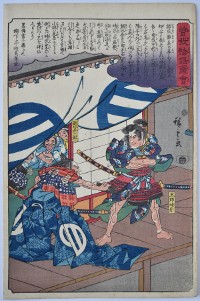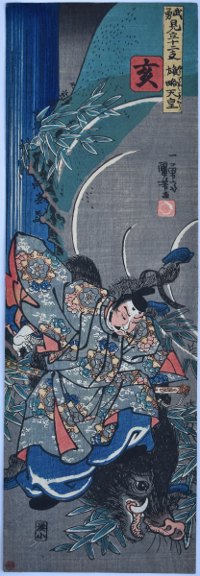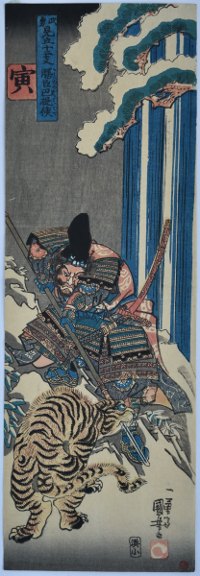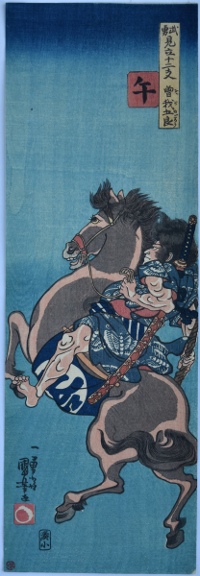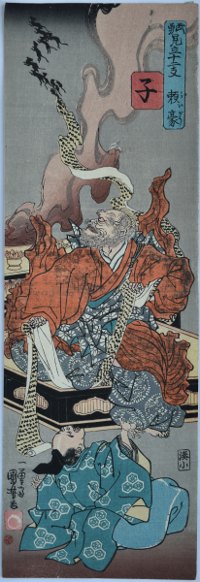Ichiryusai HIROSHIGE (1797-1858)
Click here to view image full size.
Hakomaru (Soga no Goro) stands on top of a steep cliff holding a huge boulder. From a set Soga monogatari zue, “The Revenge of the Soga Brothers.” A set of 30 prints published by Ibaya Senzaburo, 1848. This famous story has many versions but basically it tells how Kawazu Sukeyasu was murdered by his cousin Kudo Suketsune. Sukeyasu left two sons and his widow remarried a man called Soga. He adopted the two children and they waited patiently for an opportunity to kill Suketsune which came when he was hunting near Mt. Fuji. They killed him but were themselves slain in the ensuing battle. This is the first edition, it was republished in 1858 by Yamaguchiya Tobei.
Fine impression and colour. Light album backing, otherwise fine condition. Signed Hiroshige ga.
Status: Sold
Ichiryusai HIROSHIGE (1797-1858)
Click here to view image full size.
Asahina Saburo tugging on Goro Tokimune’s armour. From a set Soga monogatari zue, “The Revenge of the Soga Brothers.” A set of 30 prints published by Ibaya Senzaburo, 1848. This famous story has many versions but basically it tells how Kawazu Sukeyasu was murdered by his cousin Kudo Suketsune. Sukeyasu left two sons and his widow remarried a man called Soga. He adopted the two children and they waited patiently for an opportunity to kill Suketsune which came when he was hunting near Mt. Fuji. They killed him but were themselves slain in the ensuing battle. This is the first edition, it was republished in 1858 by Yamaguchiya Tobei.
Fine impression and colour. Light album backing, otherwise fine condition. Signed Hiroshige ga.
Status: Sold
Ichiryusai HIROSHIGE (1797-1858)
Click here to view image full size.
A noblewoman is directed to the Soga shrine by a wood-gatherer. From a set Soga monogatari zue, “The Revenge of the Soga Brothers.” A set of 30 prints published by Ibaya Senzaburo, 1848. This famous story has many versions but basically it tells how Kawazu Sukeyasu was murdered by his cousin Kudo Suketsune. Sukeyasu left two sons and his widow remarried a man called Soga. He adopted the two children and they waited patiently for an opportunity to kill Suketsune which came when he was hunting near Mt. Fuji. They killed him but were themselves slain in the ensuing battle. This is the first edition, it was republished in 1858 by Yamaguchiya Tobei.
Fine impression and colour. Light album backing, otherwise fine condition. Signed Hiroshige ga.
Status: Sold
Ichiryusai HIROSHIGE (1797-1858)
Click here to view image full size.
Goro Tokimune comes across the wrestler Goromaru. From a set Soga monogatari zue, “The Revenge of the Soga Brothers.” A set of 30 prints published by Ibaya Senzaburo, 1848. This famous story has many versions but basically it tells how Kawazu Sukeyasu was murdered by his cousin Kudo Suketsune. Sukeyasu left two sons and his widow remarried a man called Soga. He adopted the two children and they waited patiently for an opportunity to kill Suketsune which came when he was hunting near Mt. Fuji. They killed him but were themselves slain in the ensuing battle. This is the first edition, it was republished in 1858 by Yamaguchiya Tobei.
Fine impression and colour. Light album backing, otherwise fine condition. Signed Hiroshige ga.
Status: Sold
Ichiryusai HIROSHIGE (1797-1858)
Click here to view image full size.
Onio and Dozaburo, the retainers of the Soga Brothers. From a set Soga monogatari zue, “The Revenge of the Soga Brothers.” A set of 30 prints published by Ibaya Senzaburo, 1848. This famous story has many versions but basically it tells how Kawazu Sukeyasu was murdered by his cousin Kudo Suketsune. Sukeyasu left two sons and his widow remarried a man called Soga. He adopted the two children and they waited patiently for an opportunity to kill Suketsune which came when he was hunting near Mt. Fuji. They killed him but were themselves slain in the ensuing battle. This is the first edition, it was republished in 1858 by Yamaguchiya Tobei.
Fine impression and colour. Light album backing, otherwise fine condition. Signed Hiroshige ga.
Status: Sold
Katsukawa SHUNTEI (1770-1820)
Click here to view image full size.
Yamamoto Kansuke (Haruyuki) (1501-1561) overpowering a gigantic boar. Takeda Shingen’s most valuable general and one of the Takeda nijushi-sho, “Takeda’s Twenty-four [most trusted] Generals.” Kansuke was involved in a lengthy feud with Kenshin Tora and is killed in one of their skirmishes at Kawanakajima on 12 Oct. 1561.
Very good impression, colour and condition. Signed Shuntei ga.
Status: Sold
Utagawa KUNISADA (1786-1865)
Click here to view image full size.
Taira no Tadamori (1096-1153) grappling with the oil thief from a set: Honcho komei kagami, “A Mirror of our Country’s Renowned Heroes.” Published by Joshuya Kinzi, c 1835. The story relates how the Emperor Shirakawa was perturbed by a monster in the precincts of the Mido Temple at night. The samurai Taira no Tadamori was ordered to kill the beast only to discover a harmless old monk who steals a little oil from the stone lanterns. Kunisada designed a number of sets like this around this date.
Fine impression and colour. Very slightly trimmed, otherwise very good condition. Signed Kochoro Kunisada ga.
Status: Sold
Ichieisai YOSHITSUYA ( 1822-1866 )
Click here to view image full size.
Takamatsu Naizen and Tateshina Danjo Masatada grappling during the Battle of Kawanakajima in the mid 16th century. They are heavily entwined in the red ribbons of the standards. Published by Tsujiokaya Bunsuke in 1857.
Fine impression and colour. Light album backing, otherwise very good condition. Signed Ichieisai Yoshitsuya.
Status: Sold
Mori YOSHIYUKI ( 1835-1879 )
Click here to view image full size.
Shows Hido Hachiro holding the decapitated head of an enemy from Honcho buyu kagami, “Mirror of our Country’s Military Elegance.” Yoshiyuki was a pupil of Yoshiume and designed the set A Hundred Views of Osaka. He moved to Tokyo in 1868. Published by Tsutaya, c 1868. Rare: The first time I have catalogued this set.
Fine impression, colour and condition. Signed Yoshiyuki ga.
Status: Sold
Tsukioka YOSHITOSHI (1839-1892)
Click here to view image full size.
The ronin Yazama Shinroku Fujiwara Mitsukaze ) from Seichu gishinden, “Tales of True Loyalty.” From a rare uncompleted set of the 47 Ronin published 6/1868 by Masudaya. Thirteen designs extant. It has been suggested that the set was completed but that the others are not known based on the fact that two of the prints are numbered 3 and 46. An error as artists did not commence and progress from number 1. Artists chose at random which numbers from a set to start with. Well known examples being Hiroshige’s Tokaido and Kisokaido.
Very good impression and colour. Small backed wormage and light album backing. Signed Ikkaisai Yoshitoshi hitsu.
Status: Sold
Utagawa KUNIYOSHI (1798-1861)
Click here to view image full size.
Kwanyu ( Chin. Kwan Yu ), the celebrated warrior who was deified in 1591 as Kwan Ti, the God of War. Shows the warrior standing on a partially submerged boat, far right, with his long black beard and carrying a huge halberd overlooking the river battle with the Seven Armies of Gi ( Wei ). Published by Tsutaya Kichizo 1854.
Very good impression, colour and condition. Full size. Signed Ichiyusai Kuniyoshi ga.
Status: Sold
Tsukioka YOSHITOSHI (1839-1892)
Click here to view image full size.
The ronin Okudera Kouemon Fujiwara Hidetomi ( number 7 ) from Seichu gishinden, “Tales of True Loyalty.” From a rare uncompleted set of the 47 Ronin published 6/1868 by Masudaya. Thirteen designs extant. It has been suggested that the set was completed but that the others are not known based on the fact that two of the prints are numbered 3 and 46. An error as artists did not commence and progress from number 1. Artists chose at random which numbers from a set to start with. Well known examples being Hiroshige’s Tokaido and Kisokaido.
Very good impression and colour. Light album backing. Signed Ikkaisai Yoshitoshi hitsu.
Status: Sold
Tsukioka YOSHITOSHI (1839-1892)
Click here to view image full size.
The ronin Muramatsu Sandayu Fujiwara Takano ( number 46 ) from Seichu gishinden, “Tales of True Loyalty.” From a rare uncompleted set of the 47 Ronin published 6/1868 by Masudaya. Thirteen designs extant. It has been suggested that the set was completed but that the others are not known based on the fact that two of the prints are numbered 3 and 46. An error as artists did not commence and progress from number 1. Artists chose at random which numbers from a set to start with. Well known examples being Hiroshige’s Tokaido and Kisokaido.
Very good impression and colour. Small backed wormhole and light album backing. Signed Ikkaisai Yoshitoshi hitsu.
Status: Sold
Utagawa KUNISADA (1786-1864)

Click here to view image full size.
An extremely rare set of hosoban designs: Pictures of Various Women of imperial Japan. Shows, on the left, Princess Joruri – the lover of Yoshitsune. On the right Suke no Tsubone, the wet-nurse of the child Emperor Antoku who both drowned at the battle of Dan-no-ura in 1185. Published by Shimizuya Tsunejiro, 1845.
Very good impression and colour. Small repaired wormage on each sheet, otherwise very good condition. Signed Toyokuni ga.
Status: Sold
Ichieisai YOSHITSUYA (1822-1866)

Click here to view image full size.
Minamoto no Yoshitsune, on the right holding a large bow, and Benkei, in the centre, face a large white dragon which emerges amongst lightning bolts from the Koromo River at the battle of Takadachi in 1187. Bunji sannen Oshu Takadachi kassen Koromogawa yori hakuryu ten e noboru. Published by Tsujiokaya Bunsuke (Kinshodo), 1857. A fine design.
Fine impression and colour with mica applied to the dragon and silver rain. Very slight trimming, otherwise fine condition. Signed Ichieisai Yoshitsuya ga.
Status: Sold
Ichieisai YOSHITSUYA (1822-1866)

Click here to view image full size.
Higuchi no Jiro Kanemitsu, a retainer of Kiso no Yoshinaka, in the Kiso Mountains encounters a giant white baboon (ohishi) which has been terrorising the countryside and attacks it with a long bamboo spear. The creature hangs from a tree with one of Kanemitsu’s followers in its mouth. Published by Tsujiokaya Bunsuke (Kinshodo), 1858.
Very fine impression and colour. Fine condition. Signed Ichieisai Yoshitsuya ga.
Status: Sold
Tsukioka YOSHITOSHI (1839-1892)

Click here to view image full size.
A triptych showing Ban Danemon Naoyuki exorcising the Bakemono in Masanori Fukushima’s mansion. A badger ghost rears up surrounded by other goblins, one of whom attempts to appease him with tea. Fukushima no yakata ni oite Naoyuki kori o taiji no zu. Published by Tsujibun, 1866.
Fine impression, colour and condition. Signed Kaisai Yoshitoshi hitsu and Ikkaisai Yoshitoshi hitsu.
Status: Sold
Utagawa KUNIYOSHI (1797-1861)
Click here to view image full size.
Boar from a chu-tanzaku set of twelve prints Buyu mitate junishi, “Chosen Heroes for the Twelve Signs.” Based on the Chinese zodiac system of twelve animals. Shows Yuryaku Tenno, the 21st Emperor (457-480) by a waterfall killing a huge boar. Said to have occurred at Mount Katsuragi in 461. Published by Minatoya Kohei, c. 1840.
Very good impression and colour. Minimal trimming, otherwise very good condition. Signed Ichiyusai Kuniyoshi ga.
Status: Sold
Utagawa KUNIYOSHI (1797-1861)
Click here to view image full size.
Dog from a chu-tanzaku set of twelve prints Buyu mitate junishi, “Chosen Heroes for the Twelve Signs.” Based on the Chinese zodiac system of twelve animals. Shows Hata Rokurozayemon, a follower of Nitta Yoshisada, with an array of weapons and accompanied by his dog. Published by Minatoya Kohei, c. 1840.
Very good impression and colour. Minimal trimming, otherwise very good condition. Signed Ichiyusai Kuniyoshi ga.
Status: Sold
Utagawa KUNIYOSHI (1797-1861)
Click here to view image full size.
Cock from a chu-tanzaku set of twelve prints Buyu mitate junishi, “Chosen Heroes for the Twelve Signs.” Based on the Chinese zodiac system of twelve animals. Shows Kwaido Maru, the boy Kintoki, umpiring a match between a cock and a young tengu. Published by Minatoya Kohei, c. 1840.
Very good impression and colour. Minimal trimming, otherwise very good condition. Signed Ichiyusai Kuniyoshi ga.
Status: Sold
Kobayashi KIYOCHIKA (1847-1915)
Click here to view image full size.
A triptych, Akechi Samanosuke Mitsuhara kosui joho Karasaki matsu no zu. Shows Akechi Samanosuke Mitsuhara swimming with his horse, his kikyo (Chinese bell flower) standard tied to his back, across Lake Biwa to his cousin’s house at Sakamoto where he kills Mitsuhide’s wife and children to prevent them being captured. The Karasaki pine can be seen in the background. The event takes place in 1582. One of Kiyochika’s best designs. Published 1899.
Fine impression and colour. Album backing and slight vertical fold on centre panel. Signed Kiyochika hitsu.
Status: Sold
Utagawa KUNIYOSHI (1797-1861)
Click here to view image full size.
Snake from a chu-tanzaku set of twelve prints Buyu mitate junishi, “Chosen Heroes for the Twelve Signs.” Based on the Chinese zodiac system of twelve animals. Shows Nitta Shiro (Tadatsune) inside Mount Fuji during Yoritomo’s hunting party (1193) encountering snakes and a vision of the goddess of the mountain. Published by Minatoya Kohei, c. 1840.
Very good impression and colour. Minimal trimming, otherwise very good condition. Signed Ichiyusai Kuniyoshi ga.
Status: Sold
Utagawa KUNIYOSHI (1797-1861)
Click here to view image full size.
Tiger from a chu-tanzaku set of twelve prints Buyu mitate junishi, “Chosen Heroes for the Twelve Signs.” Based on the Chinese zodiac system of twelve animals. Shows Kashiwade no Omi Hatebe (sic, usually Hadesu) engaging with a tiger that had killed his daughter. Published by Minatoya Kohei, c. 1840.
Very good impression and colour. Minimal trimming, otherwise very good condition. Signed Ichiyusai Kuniyoshi ga.
Status: Sold
Utagawa KUNIYOSHI (1797-1861)
Click here to view image full size.
Dragon from a chu-tanzaku set of twelve prints Buyu mitate junishi, “Chosen Heroes for the Twelve Signs.” Based on the Chinese zodiac system of twelve animals. Shows Susa-no-o-no-Mikoto standing on a rock and observing a dragon under the waves. (Probably the eight-headed dragon he slew in Idzumo.) Published by Minatoya Kohei, c. 1840.
Very good impression and colour. Minimal trimming, otherwise very good condition. Signed Ichiyusai Kuniyoshi ga.
Status: Sold
Utagawa KUNIYOSHI (1797-1861)
Click here to view image full size.
Hare from a chu-tanzaku set of twelve prints Buyu mitate junishi, “Chosen Heroes for the Twelve Signs.” Based on the Chinese zodiac system of twelve animals. Shows Iga Jutaro, the elderly retainer of Soma Yoshikado, sacrificing a hare in a Buddhist temple. Published by Minatoya Kohei, c. 1840.
Very good impression and colour. Minimal trimming, otherwise very good condition. Signed Ichiyusai Kuniyoshi ga.
Status: Sold
Kobayashi KIYOCHIKA (1847-1915)
Click here to view image full size.
A triptych, Ujigawa Kajiwara Kagesue, Sasaki Takatsuna, miju uma. Yoshitsune is informed that Kiso no Yoshinaka is entrenched behind the natural defence of the Uji river, then in full flood. Yoshitsune calls on Kajiwara Kagesue and Sayemon-no-jo Sasaki Shiro Takatsuna to make an attempt at fording the river. He gives them his best horses: Surusumi to Kagesue and Iketsuki to Takatsuna. They plunge into the river with Takatsuna, dodging the hail of arrows, arriving first. One of Kiyochika’s best designs. Published 1899.
Fine impression and colour. Album backing and slight vertical fold on centre panel. Signed Kiyochika.
Status: Sold
Utagawa KUNIYOSHI (1797-1861)
Click here to view image full size.
Monkey from a chu-tanzaku set of twelve prints Buyu mitate junishi, “Chosen Heroes for the Twelve Signs.” Based on the Chinese zodiac system of twelve animals. Shows the Monkey King, Songoku (Sun Wu K’ung) conjuring up an army of monkeys to attack his enemy the pig. Published by Minatoya Kohei, c. 1840.
Very good impression and colour. Minimal trimming, otherwise very good condition. Signed Ichiyusai Kuniyoshi ga.
Status: Sold
Utagawa KUNIYOSHI (1797-1861)
Click here to view image full size.
Ox from a chu-tanzaku set of twelve prints Buyu mitate junishi, “Chosen Heroes for the Twelve Signs.” Based on the Chinese zodiac system of twelve animals. Shows the robber Kidomaru under a buffalo hide looking at his reflection in water while attempting to ambush and kill Raiko. Published by Minatoya Kohei, c. 1840.
Very good impression and colour. Minimal trimming, otherwise very good condition. Signed Ichiyusai Kuniyoshi ga.
Status: Sold
Utagawa KUNIYOSHI (1797-1861)
Click here to view image full size.
Horse from a chu-tanzaku set of twelve prints Buyu mitate junishi, “Chosen Heroes for the Twelve Signs.” Based on the Chinese zodiac system of twelve animals. Shows Soga Goro (Tokimune) galloping from Hakone to Mount Fuji to meet his brother Juro and fulfill their revenge in the course of Yoritomo’s great hunting party in 1193. Published by Minatoya Kohei, c. 1840.
Very good impression and colour. Minimal trimming, otherwise very good condition. Signed Ichiyusai Kuniyoshi ga.
Status: Sold
Utagawa KUNIYOSHI (1797-1861)
Click here to view image full size.
Goat from a chu-tanzaku set of twelve prints Buyu mitate junishi, “Chosen Heroes for the Twelve Signs.” Based on the Chinese zodiac system of twelve animals. Shows the Chinese hero Kwanu (Kuan Yu) seated drinking under a pine tree with a goat. Published by Minatoya Kohei, c. 1840.
Very good impression and colour. Minimal trimming, otherwise very good condition. Signed Ichiyusai Kuniyoshi ga.
Status: Sold
Utagawa KUNIYOSHI (1797-1861)
Click here to view image full size.
Rat from a chu-tanzaku set of twelve prints Buyu mitate junishi, “Chosen Heroes for the Twelve Signs.” Based on the Chinese zodiac system of twelve animals. Shows Raigo Ajari at the Onjoji monastery, Miidera, turning the Buddhist scriptures into rats. Oye no Masafusa looks on in dismay. Published by Minatoya Kohei, c. 1840.
Very good impression and colour. Minimal trimming, otherwise very good condition. Signed Ichiyusai Kuniyoshi ga.
Status: Sold
Utagawa KUNIYOSHI (1797-1861)
Click here to view image full size.
Shows Tametomo’s faithful retainer Kiheiji who is left behind by mistake when Tametomo sails for Japan from the Ryukyu Islands. He throws a weighted rope the immense distance to the ship and is hauled in. The best design from Tametomo homare no jikketsu, “Ten Famous Excellences of Tametomo.” A set of ten prints published by Aritaya Seiyemon, c. 1848-51.
Fine impression and colour. Slight trimming, otherwise very good condition. Signed Ichiyusai Kuniyoshi ga.
Status: Sold
Utagawa KUNIYOSHI (1797-1861)
Click here to view image full size.
Tominomori Sukeemon Masakata, one of the famed Forty-seven Ronin, sword drawn, during the famous night attack on the house of Kono Moronao. The hanging bell, above, was an early intruder alarm system. (Interestingly, it’s also said that squeaks were deliberately incorporated into wooden floors for the same reason.) This unusual western-style set is also rare in having the printer’s name, Ohisa Daiihitsu, on five (including this) of the twelve prints in the set. Published by Sumiyoshiya Masagoro, 1852.
Fine impression and colour. Slight trimming, otherwise very good condition. Signed Kuniyoshi ga.
Status: Sold
Utagawa SADAHIDE (1807-1873)
Click here to view image full size.
Iwanari Chikara no Suke and Shimozu Gonnai struggling in the water from Eimei kumiuchi soroi, “A Series of Famous Fighting Warriors.” Published by Moriya Jihei, 1865.
Fine impression, colour and condition. Signed Gountei Sadahide ga.
Status: Sold
Taiso YOSHITOSHI (1839-1892)
Click here to view image full size.
Sagaminokami Hojo Takatoki warding off a group of tengu with his fan. From the fine set Yoshitoshi mushaburui, “Yoshitoshi’s Courageous Warriors.” Published by Kobayashi, 1883-1886 (this being 1883).
Fine impression and colour. Light toning, otherwise fine condition. This is the first edition. There are a number of later states and the set was republished by Tsunajima in 1886.
Status: Sold
Taiso YOSHITOSHI (1839-1892)
Click here to view image full size.
Sano Genzaemon cutting his potted trees to warn Hojo Tokiyori. From the fine set Yoshitoshi mushaburui, “Yoshitoshi’s Courageous Warriors.” Published by Kobayashi, 1883-1886 (this being 1883).
Fine impression and colour. Light toning, otherwise fine condition. This is the first edition. There are a number of later states and the set was republished by Tsunajima in 1886.
Status: Sold
Taiso YOSHITOSHI (1839-1892)
Click here to view image full size.
Danjo Matsunaga Hisahide preparing to commit suicide. From the fine set Yoshitoshi mushaburui, “Yoshitoshi’s Courageous Warriors.” Published by Kobayashi, 1883-1886 (this being 1883).
Fine impression and colour. Light toning, otherwise fine condition. This is the first edition. There are a number of later states and the set was republished by Tsunajima in 1886.
Status: Sold
Taiso YOSHITOSHI (1839-1892)
Click here to view image full size.
Kuro Hangan Yoshitsune and Notonokami Noritsune fighting on a ship’s prow. From the fine set Yoshitoshi mushaburui, “Yoshitoshi’s Courageous Warriors.” Published by Kobayashi, 1883-1886 (this being 1886).
Fine impression and colour. Light toning, otherwise fine condition. Early edition. There are a number of later states and the set was republished by Tsunajima in 1886.
Status: Sold
Tsukioka YOSHITOSHI (1839-1892)

Click here to view image full size.
A chuban print from a set Wakan goki zoroi, “Valour in China and Japan.” Shows Kintaro about to deliver a blow to the Thunder God Raijin (the God of thunder and lightning – a Japanese Thor). Published by Daisada, 1868. A rare set.
Fine impression, colour and condition. Signed Ikkaisai Yoshitoshi hitsu.
Status: Sold
Utagawa KUNIYOSHI (1797-1861)

Click here to view image full size.
Wada Heita Tanenaga (1182-1213), short sword in hand, struggling with a giant python. He was a renowned archer and retainer of Minamoto no Yoriie. Various stories tell of how he came across the python in a cave or saved a village from its carnivorous attacks. From an untitled early set published by Yamashiroya Heisuke, c. 1845. Robinson S1f.8. A striking design and rare.
Very good impression and colour. Slight trimming, otherwise very good condition. Signed Ichiyusai Kuniyoshi ga.
Status: Sold

